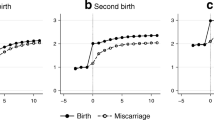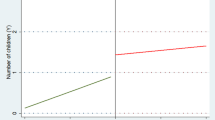Abstract
Although difficulty conceiving a child has long been a major medical and social preoccupation, it has not been considered as a predictor of long-term outcomes in children ultimately conceived. This is consistent with a broader gap in knowledge regarding the consequences of parental health for educational performance in offspring. Here we address that omission, asking how resolved parental infertility relates to children’s academic achievement. In a sample of all Swedish births between 1988 and 1995, we find that involuntary childlessness prior to either a first or a second birth is associated with lower academic achievement (both test scores and GPA) in children at age 16, even if the period of infertility was prior to a sibling’s birth rather than the child’s own. Our results support a conceptualization of infertility as a cumulative physical and social experience with effects extending well beyond the point at which a child is born, and emphasize the need to better understand how specific parental health conditions constrain children’s educational outcomes.
Similar content being viewed by others
Notes
The term “infertility” is used here as per the medical definition, describing a failure to attain a live birth despite consistent exposure to pregnancy risk (Mascarenhas et al. 2013; WHO 1991). Medical infertility is thus largely synonymous with infecundity; find more on this point in the Methods and Analysis section.
Our measure of infertility is based on the time to a live birth. We unfortunately lack information on whether mothers miscarried during that period unless the miscarriage was late enough in a pregnancy to qualify as a stillbirth or otherwise require hospitalization. Cases of stillbirth were very few and were omitted from the sample.
Grades range from A to F, with E as the lowest passing grade. A top score (“pass with special distinction”) is equivalent to 20 points, and a minimal passing score is equivalent to 10 points.
Test scores in Swedish and English are reported as an ordinal measure (Fail, Pass, Pass with distinction, Pass with high distinction). Running linear probability models using “Pass with high distinction” in Swedish language as the outcome, we obtain results similar to those presented for math. No results are found for English.
The mean number of children in the full registry sample over the time frame defined here was 1.72. Families with only one child constituted 43 % of the full sample; families with two children constituted 44 %; with three children, 11 %; with four or more children, 1.6 %.
Although paternal health is also an important consideration in understanding causes of infertility, paternal health behaviors (such as smoking) were not recorded in the MBR.
The measurement of demographic controls at age 14 and test scores at age 16 reflects data availability rather than an effort to lag covariates. Lifetime earnings are calculated as per Lindahl et al. (2015).
Additional specifications included using indicators for each year of infertility, each two years of infertility, and including C as a continuous measure with higher-order terms. Results were substantively the same as those presented using the two-category specification of C. Frequencies of primary and secondary infertility for zero through five or more years are presented in Table S5, Online Resource 1.
Couples who experienced five or more years of infertility are rare, and couples who experienced five or more years of infertility before both a first and a second birth are extremely rare (<0.1 % of the sample). Coefficients on the remaining interactions between C i and S i were in the same direction as for the interaction presented but with volatility in magnitudes, given the dramatically declining cell sizes.
Sexually transmitted infections (STIs) could be a particularly useful set of controls in this case, given the higher rates of STIs in Scandinavian countries relative to other Western European nations (European Centre for Disease Prevention and Control 2011). In addition to the medical consequences of STIs for fertility, STI prevalence may be indicative of country-specific cultural norms that also reflect other aspects of lifestyle relevant for parenting.
References
Bernhardt, E., & Goldscheider, F. (2014). Ambivalence about children in the family building process in Sweden. Finnish Yearbook of Population Research, 49, 57–71.
Biringer, E., Howard, L. M., Kessler, U., Stewart, R., & Mykletun, A. (2015). Is infertility really associated with higher levels of mental distress in the female population? Results from the North-Trøndelag Health Study and the Medical Birth Registry of Norway. Journal of Psychosomatic Obstetrics and Gynecology, 36, 38–45.
Bratti, M., & Mendola, M. (2013). Parental health and child schooling (GINI Discussion Paper No. 63). Amsterdam, The Netherlands: Amsterdam Institute for Advanced Labour Studies.
Canadian Paediatric Society. (2004). Maternal depression and child development. Paediatrics & Child Health, 9, 575–583.
Cohen, J., Trounson, A., Dawson, K., Jones, H., Hazekamp, J., Nygren, K.-G., & Hamberger, L. (2005). The early days of IVF outside the UK. Human Reproduction Update, 11, 439–460.
Cousineau, T. M., & Domar, A. D. (2007). Psychological impact of infertility. Best Practice & Research: Clinical Obstetrics and Gynaecology, 21, 293–308.
Crosnoe, R., & Muller, C. (2004). Body mass index, academic achievement, and school context: Examining the educational experiences of adolescents at risk of obesity. Journal of Health and Social Behavior, 45, 393–407.
Cummings, E. M., & Davies, P. T. (1994). Maternal depression and child development. Journal of Child Psychology and Psychiatry, 35, 73–122.
Downey, G., & Coyne, J. C. (1990). Children of depressed parents: An integrative review. Psychological Bulletin, 108, 50–76.
Eisenberg, M. L., Li, S., Behr, B., Reijo Pera, R., & Cullen, M. R. (2015). Relationship between semen production and medical comorbidity. Fertility and Sterility, 103, 66–71.
Espeland, W. N., & Stevens, M. L. (2008). A sociology of quantification. European Journal of Sociology, 49, 401–436.
European Centre for Disease Prevention and Control. (2011). Sexually transmitted infections in Europe, 1990–2009 (Surveillance report). Stockholm, Sweden: ECDC.
Falbo, T., & Polit, D. F. (1986). Quantitative review of the only child literature: Research evidence and theory development. Psychological Bulletin, 100, 176–189.
Gibson, F. L., McMahon, C. A., Cohen, J., Leslie, G. I., & Saunders, D. M. (2002). Children conceived through ICSI and IVF at 5 years of age: Behavioral adjustment, parenting stress and attitudes: A comparative study. Fertility and Sterility, 78(Suppl. 1), S28–S29.
Greil, A. L., McQuillan, J., & Slauson-Blevins, K. (2011). The social construction of infertility. Sociology Compass, 5, 736–746.
Greil, A. L., Slauson-Blevins, K., & McQuillan, J. (2010). The experience of infertility: A review of recent literature. Sociology of Health & Illness, 32, 140–162.
Hammarberg, K., Fisher, J. R. W., & Wynter, K. H. (2008). Psychological and social aspects of pregnancy, childbirth and early parenting after assisted conception: A systematic review. Human Reproduction Update, 14, 395–414.
Haveman, R., & Wolfe, B. (1995). The determinants of children’s attainments: A review of methods and findings. Journal of Economic Literature, 33, 1829–1878.
Irvine, D. S. (1998). Epidemiology and aetiology of male infertility. Human Reproduction, 13(Suppl. 1), 33–44.
Kaestner, R., & Grossman, M. (2009). Effects of weight on children’s educational achievement. Economics of Education Review, 28, 651–661.
Kaestner, R., Grossman, M., & Yarnoff, B. (2011). Effects of weight on adolescent educational attainment. In M. Grossman & N. H. Mocan (Eds.), Economic aspects of obesity (pp. 283–313). Chicago, IL: University of Chicago Press.
Katz, P., Showstack, J., Smith, J. F., Nachtigall, R. D., Millstein, S. G., Wing, H., . . . Adler, N. (2011). Costs of infertility treatment: Results from an 18-month prospective cohort study. Fertility and Sterility, 95, 915–921.
Kelly, S. (2008). What types of students’ effort are rewarded with high marks? Sociology of Education, 81, 32–52.
Lane, M., Robker, R. L., & Robertson, S. A. (2014). Parenting from before conception. Science, 345, 756. doi:10.1126/science.1254400
Levy-Shiff, R., Vakil, E., Dimitrovsky, L., Abramovitz, M., Shahar, N., Har-Even, D., . . . Fish, B. (1998). Medical, cognitive, emotional, and behavioral outcomes in school-age children conceived by in-vitro fertilization. Journal of Clinical Child Psychology, 27, 320–329.
Lindahl, M., Palme, M., Sandgren Massih, S., & Sjögren, A. (2015). Long-term intergenerational persistence of human capital: An empirical analysis of four generations. Journal of Human Resources, 50, 1–33.
Mascarenhas, M. N., Flaxman, S. R., Boerma, T., Vanderpoel, S., Mathers, C. D., & Stevens, G. A. (2013). Trends in primary and secondary infertility prevalence since 1990: A systematic analysis of demographic and reproductive health surveys. Lancet, 381(Special Issue), S90. doi:10.1016/S0140-6736(13)61344-6
McMahon, C., & Gibson, F. (2002). A special path to parenthood: Parent-child relationships in families giving birth to singleton infants through IVF. Reproductive Biomedicine Online, 5, 179–186. doi:10.1016/S1472-6483(10)61622-7
Mikail, S. F., & von Baeyer, C. L. (1990). Pain, somatic focus, and emotional adjustment in children of chronic headache sufferers and controls. Social Science & Medicine, 31, 51–59.
Milesi, C., Palloni, A., & Bittman, R. (2013, April). The effects of timing and duration of adolescent and early adulthood obesity on college enrollment and completion. Paper presented at the annual meetings of the Population Association of America, New Orleans, LA.
Möller, A., & Fällström, K. (1991). Psychological consequences of infertility: A longitudinal study. Journal of Psychosomatic Obstetrics and Gynecology, 12, 27–44.
Morice, P., Josset, P., Chapron, C., & Dubuisson, J. B. (1995). History of infertility. Human Reproduction Update, 1, 497–504.
Muthler, S. (2013, July 24). Secondary infertility: I have one child. Why can’t I get pregnant again? The New York Times. Retrieved from http://parenting.blogs.nytimes.com/2013/07/24/secondary-infertility-i-have-one-child-why-cant-i-get-pregnant-again/
Olshansky, E., & Sereika, S. (2005). The transition from pregnancy to postpartum in previously infertile women: A focus on depression. Archives of Psychiatric Nursing, 19, 273–280.
Rickard, K. (1988). The occurrence of maladaptive health-related behaviors and teacher-rated conduct problems in children of chronic low back pain patients. Journal of Behavioral Medicine, 11, 107–116.
Scritchfield, S. (2009). The social construction of infertility: From private matter to social concern. In J. Best (Ed.), Images of issues: Typifying contemporary social problems (pp. 131–146). New Brunswick, NJ: Transaction Publishers.
Sullivan, W. (1981, December 29). First “test-tube” baby born in U.S., Joining successes around world. The New York Times, pp. 1A.
Timmermans, S., & Haas, S. (2008). Towards a sociology of disease. Sociology of Health & Illness, 30, 659–676.
World Health Organization (WHO). (1991). Infertility: A tabulation of available data on prevalence of primary and secondary infertility [Database]. Geneva, Switzerland: World Health Organization.
Yeung, W. J., Linver, M. R., & Brooks-Gunn, J. (2002). How money matters for young children’s development: Parental investment and family processes. Child Development, 73, 1861–1879.
Acknowledgments
The authors acknowledge funding from the Centre for Economic Demography and from the Cornell Population Center, and additionally thank participants at the seminars in the Centre for Economic Demography and the Cornell Population Center, who provided invaluable feedback on this manuscript.
Author information
Authors and Affiliations
Corresponding author
Electronic supplementary material
ESM 1
(DOCX 151 kb)
Rights and permissions
About this article
Cite this article
Branigan, A.R., Helgertz, J. Resolved Parental Infertility and Children’s Educational Achievement. Demography 54, 911–931 (2017). https://doi.org/10.1007/s13524-017-0573-3
Published:
Issue Date:
DOI: https://doi.org/10.1007/s13524-017-0573-3




